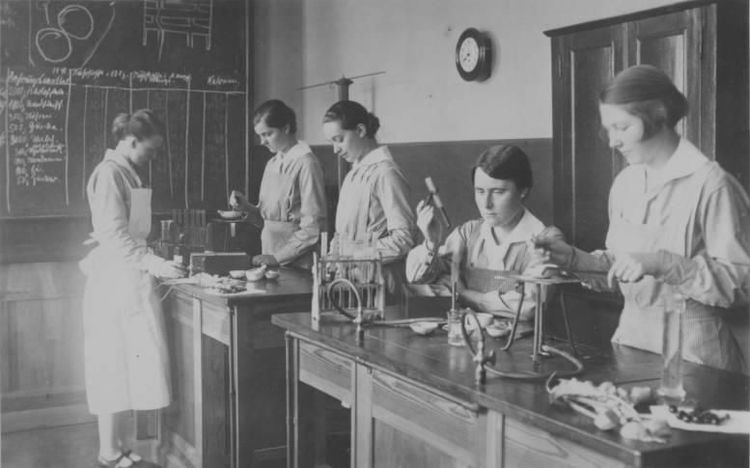 | ||
The Reifenstein schools (German: Reifensteiner Schulen) were the various schools of higher education for women associated with the Reifensteiner Verband.
Contents
The concept was initiated by Ida von Kortzfleisch, a Prussian noble woman and early German feminist. Reifenstein refers to Reifenstein in Eichsfeld, a municipality in Thuringia and site of the first permanent school. From 1897 to 1990 the Reifensteiner Verband operated about 15 of its own schools and cooperated with further operators. About 40 wirtschaftliche Frauenschulen, rural women economy schools were connected to the Reifenstein concept and movement. The association and its journals served as alumni network, provided a job placement service, strengthened home economics (Ekotrophology) as an academic discipline and were important for consumer advice and rural social services over all. About 90,000 women took the higher education courses. Some of the alumni, like Käthe Delius, Marie-Elisabeth Lüders und Freya von Moltke had an important role in German higher education and German society overall.
Background
Under the German Empire until the early 20th century, household services played a central role for the employment of women. Instead of a systematic training as in the dual system of vocational education, the education of women in the countryside happened often along a training on the job principle. Young men at this time often gained skils from winter schools and various professional educational institutions. The rural women's education (or their shortcomings) was being deemed a troubled sector and a main topic of the early women's movement.
Already a 1913 doctorate, Joachim Kramer's thesis about the household education in Germany refers to the ongoing reform aspects. The 1870s saw some progress; the first winter schools had been founded by the Badische Frauenverein, founded by Princess Louise of Prussia in the state of Baden. While the winter schools lost their impact to permanent schools in Baden already before World War I, they gained importance in Bavaria in the 1920s. Kramer compared the German situation and the state of household education abroad. Switzerland, Belgium and Austria had winter schools. The Austrian education for rural women was comparably backward, and Switzerland took a leading position. In France, housekeeping was a topic in primary schools, but not part of higher education. According to Kramer, Iowa and the state of New York in the United States were then leading in the field.
The technical equipment and available technology for households gained importance in the 19th century. According to Hans Jürgen Teuteberg, the household literature then started to address women. Earlier works, like the Hausväterliteratur (Hlaford books, a German kind of early economic literature) addressed the pater familias, male and noble heads of larger rural households. Within the second half of the 19th century, women - as house mother or housewives were being perceived and addressed. The new role of the house wife as head of the household was being deemed a positive development first and only later as "how housewives were being made" being deemed negatively.
Ida von Kortzfleisch
In 1894, Ida von Kortzfleisch published an article in Tägliche Rundschau, a Berlin newspaper called The Female compulsory service in the economist college for women. She responded to a series of articles by the writer Otto Leixner about the Female Question in Germany. Leixner had loathed the women's rights movement (as Weiberrechtlerinnen) and he had deplored their alleged lack of patriotism. She asked to establish a female service year, similar to the Einjährige, a year of military service of male graduates of high schools. Ida von Kortzfleisch explicitly associated her efforts with women's right's as a citizen in the Kaiserreich. The controversy distributed to establish higher education for women in the wirtschaftliche Frauenschule.
Development
The first classes started in Ofleiden, but was transferred to Reifenstein soon after. The states of Prussia provided an official acknowledgement in 1909. In 1913, the Reifenstein association was admitted to the Bund Deutscher Frauenvereine. The conservative and basically Protestant background did not hinder a cooperation with the Jüdische Frauenbund (Jewish women's association), which established a Jewish Reifenstein school in Wolfratshausen in 1926.
The Reifenstein association and its schools was included in the Reichsnährstand in 1934. The noble background of various pupils and the close connection to the Protestant church lead to some clashes with the regime.
Bad Weilbach, Chattenbühl, Obernkirchen, Wittgenstein and Wöltingerode reopened 1946 in the western occupation zones. The eastern parts went into state ownership in 1947. Some of the schools in the far Eastern part of Prussia, e.g. the Landfrauenschule Metgethen have been destroyed during the end of war. The 1960s saw major changes in the concept, e.g. the end of the compulsory maiden costume. The first male student was admitted 1980. The last two schools closed down in the 1990s and are now part of a Protestant youth organization.
Trivia
Marie-Elisabeth Lüders reported about mocking remarks from Berlin friends about the rural sites and background of the schools. Carry Brachvogel provided material for improved household knowledge in Bavaria. She deplored the lack of quality cuisine in the free state of Bavaria and expected some improvements via the training courses provided by teachers trained in Reifenstein schools. The Bayerische Kochbuch (Bavarian Cookbook), a still famous household item, is not about specific Bavarian menus, but is based on the experience of the school in Miesbach.
Famous pupils
List of schools
The table contains schools owned by the Reifensteiner Verband. A further 25 schools have been associated with the Reifenstein concept, among them a school in Stift Finn in Estonia (1922-1939) and Lehrfarm (training farm) Brakwater, near Windhuk in the then German colony of Südwestafrika (Namibia). The name of Maid (older German for Miss or maiden) refers to the acronym Mut, Ausdauer, Idealismus und Demut (Courage, perseverance, idealism and humility). The symbols worne by the Maiden are valuable collectors items in the meanwhile, some tried to relate them with the Arbeitsmaiden of the Nazi Reichsarbeitsdienst, which are however not connected in any way.
